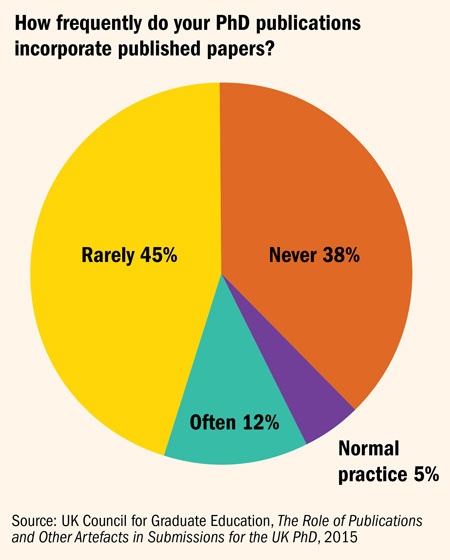Earlier this year, Jeremy Farrar, director of the Wellcome Trust, examined a PhD candidate at Imperial College London. Although the student “sailed through”, Farrar was struck by how much time he had spent writing up his thesis compared with carrying out experiments.
“Is it time to look at the PhD thesis?” he wondered aloud on Twitter. “What is best for candidate and research in the 21st century?”
He estimates that the average doctoral student spends about six months of their four-year programme writing their thesis, and another three “waiting for it to be examined”.
“That is just not a wise balance,” he says – particularly when even examiners rarely have the time to “wade through” theses in their entirety.
“An awful lot is going unused and unread,” he says. “Is this really appropriate for the modern world? Communication within the science world and with the public is becoming shorter and snappier, yet our PhDs still seem to be stuck in the 1960s.”
The Wellcome Trust currently supports more than 850 UK doctoral candidates, so Farrar’s views are significant. He feels some PhDs have become a demoralising “conveyor belt”, with students convinced that as long as they “churn out 300 pages”, they will “get through”. Hence, theses become bloated with “page after page of methods”, along the lines of: “I pipetted 2.5ml of this enzyme into that tube.”
Philip Moriarty, professor of physics at the University of Nottingham, also worries about wasted effort. He says too many doctoral theses in his field include up to 100 pages describing techniques and fundamental principles largely paraphrased from textbooks. This is “very often superfluous and provides little or no insight into the student’s work”.
He would much prefer to see theses’ introductory sections “written along the lines of a good review article, where the student does a critical appraisal of the state of the field”.
But what about going further and abolishing the thesis entirely, and instead allowing students to submit a bundle of papers? For several decades most UK universities have offered doctorates “by prior publication”, but these are usually confined to staff and (sometimes) former students who have already published a substantial body of work that adds up to a unique contribution to knowledge. However, according to The Role of Publications and Other Artefacts in Submissions for the UK PhD, a report published earlier this year by the UK Council for Graduate Education, 72 per cent of 50 UK universities surveyed sometimes saw published papers incorporated into PhD submissions – although it was the norm in just 2 per cent of cases and was rare or absent in 83 per cent. A spokeswoman for Imperial says that the institution “does not currently accept a series of papers for submission as a thesis, although we are continuing to explore the possibility of accepting alternative PhD thesis formats”.
The “integrated format”, as the UKCGE calls it, is already common in many European countries, for which reason it is sometimes known as the “continental model”. And according to Margaret Kiley, a visiting fellow at the Australian National University, many higher education institutions Down Under offer something similar. The UKCGE report attributes the integrated format’s rise to growing pressure on students, particularly in the sciences, to publish their findings prior to graduation – not least so that they can compete for postdoctoral positions in an increasingly international job market. Some universities also want to eliminate the “opportunity cost to the institution if the PhD regulations forced candidates to rewrite…pre-published material”.
However, there is also a “general consensus” that the bundle of papers submitted “needs to be coherent and to demonstrate explicitly the candidate’s individual contribution to knowledge”. The UKCGE itself, in a statement issued to Times Higher Education, notes that examiners “need to be confident that the research has been conducted soundly, securely, ethically and with a robust methodology. Therefore it is necessary for a PhD thesis to contain more information than other types of publication that researchers might produce later in their careers when they become more established. Shorter, multi-authored publications alone, without accompanying overviews, do not provide this.”
The report’s lead author, Bruce Christianson, professor of informatics at the University of Hertfordshire, says that universities typically require students to append an introduction, setting out the context in which the papers fit, and a critical summary at the end, bringing all the strands together. Despite all that, he estimates that the amount of material candidates have to write from scratch under the integrated format is about a fifth of that required for a traditional thesis.
Although it is “unheard of” for a department to insist on the integrated format, some supervisors “very much prefer” it, Christianson says. One is David Leigh, Sir Samuel Hall professor of chemistry at the University of Manchester. He has successfully “encouraged” all but one of his doctoral students during the past dozen years to submit for examination a series of papers, published or not – including the literature review favoured by Moriarty.
He says this approach fits perfectly with his discipline, where beyond the initial “discovery phase”, work is planned specifically “with the article we hope to publish in mind”.
“It makes no sense to rewrite the work in a way [that was not intended] and dissect out just your own little contribution to the team’s work in order to report it in a PhD thesis,” he says.
As well as teaching students how to plan and write papers, Leigh adds, the approach also teaches them “how to plan and execute a research project efficiently and effectively; focusing at a relatively early stage on what needs to be done rather than…carrying out a lot of experiments…sitting down to write the paper and only then realising that to publish the story they need some model compounds that they haven’t made yet and don’t need some of the others that they have spent much time and effort making”.
Any potential loss of information to future group members about tried and failed approaches (which typically aren’t reported in papers) is compensated for by requiring everyone in the lab to produce monthly “flowsheets” setting out what they have done, which are then stored in a “group repository”. Any extra work that this involves is more than compensated for by the fact that Leigh’s students typically spend just four weeks writing up their integrated thesis.
One concern about the integrated format voiced by many respondents to the UKCGE survey is that it can be difficult to identify students’ individual contributions to multi-author papers; 64 per cent of institutions require each student to state their own contribution to each paper and 22 per cent require claims to be endorsed by the co-authors. According to Christianson, such measures make it harder for students to “fudge” their own contributions, as they can in the traditional thesis.
Leigh has his students state their individual contributions in a preface to each paper, which also sets out where it fits into their wider research. Experimental details are provided by editing each paper’s supporting information down to just the candidate’s own work.
Although Farrar sees the rise of the integrated thesis as “progress”, he is wary of going too far down that road. He is concerned that the approach risks turning the PhD into a “paper machine” that disadvantages candidates who are unlucky with their experiments and pushes supervisors to avoid any project that doesn’t obviously hold out the promise of a paper – “and there is already too much of that in science”.
But Leigh argues that unlucky students with no results “shouldn’t be getting a PhD anyway”, since the degree is awarded “for a contribution to knowledge, not for a good try”. He does not require his students to produce any particular number of papers (five is typical but numbers range from three to nine) and insists that the level of results they have to achieve is no different from that required for a traditional thesis.
Since his lab always lists the names of paper authors alphabetically, there is no issue about authorship order. But Leigh accepts that other labs and disciplines in which order is determined by often fraught judgements about each author’s contribution could run into problems with the integrated format – if a university department insisted on a particular authorship position before a paper could be submitted as part of an integrated thesis.
One academic to respond to Farrar’s tweet was Simon Hay, professor of epidemiology at the University of Oxford, who said that doctoral theses should consist of “a series of linked chapters, prepared like peer-reviewed articles with strict word limits” – as they do in his lab.
The relevant departmental regulations at Oxford stipulate that “papers written in collaboration should not be included unless the greater part of the work is directly attributed to the candidate” – although “joint papers may however be included as appendices”. The latter provision allowed one of Hay’s current doctoral candidates, Oliver Brady, to include a Nature paper on which he was a minor author as an appendix to his thesis, and to write a chapter expanding on his role in the project based on ample “supplementary information” published alongside the paper.
That decision, Brady says, was based on the fact that his contribution “formed a significant and independent body of work that could have been published in isolation, but was instead combined with other complementary work in order to obtain a higher impact publication”. He adds that a previous student of Hay’s was able to combine several papers on which she was second author into a single thesis chapter.

He sees the thesis as the ‘gold standard’, since it remains the best means by which to capture ‘the unfolding of the mind’ that a doctorate constitutes
Such “hybrid” approaches, which allow students to “demonstrate their contribution to a larger piece of published work”, would also be helpful in groups with fiercely hierarchical structures, Brady adds. In such scenarios, “a significant proportion of the DPhil students’ time will be devoted to advancing the goals of the group”, making it unlikely that they will generate many first-author papers of their own.
Everyone appears to accept that the integrated format is not appropriate for all students, labs and disciplines, and that the traditional thesis still has its merits. Moriarty – who is not aware of any opportunity at Nottingham to switch to the integrated format – notes that part of the laudable trend towards equipping doctoral students with transferable skills should include ensuring they are capable of “clear and coherent writing”. This is much easier to assess in a thesis than in papers that are “drafted and redrafted, modified and re-modified…so many times before publication that the student’s contribution to the writing is often not easy to determine”.
Andrew Harrison, chief executive of the Diamond Light Source synchrotron in Harwell, Oxfordshire – which offers PhDs in collaboration with numerous universities – also thinks there is “some merit in testing how well students can express themselves through the written word without the intervention of the paper’s editors”. He stresses the importance of doctoral candidates putting together a body of work “that supports a thesis – in the ‘proposition’ sense of the word – because this demonstrates a rather broader approach and a more in-depth view of problems than would be common in individual papers”. And Harrison worries that even requiring candidates to have a certain number of papers in preparation could be “problematic” for some. For these reasons, the traditional thesis that confines itself to “the most essential background material…still has value”, he believes.
Robert Bowman, director of the Centre for Nanostructured Media at Queen’s University Belfast, says there have been discussions at his institution about moving to the integrated format, and he believes that a “hybrid” system will ultimately come into existence. But he prefers the traditional thesis.
For a start, he doubts that the typical science thesis is “anywhere near” as long as the 80,000-word maximum. Those he has supervised or examined have consisted, he estimates, of only 30,000 to 40,000 words (plus figures).
“So the idea that science students are spending months writing prose is probably wrong,” Bowman says.
Furthermore, research in his field is “messy and doesn’t immediately lead to a few neat, tidy papers”. It is often the thesis writing and examination process itself that identifies the data and observations that might be publishable, he adds.
Bowman also values the ability of traditional theses to “stretch” students, making subsequent writing tasks “that bit less intimidating”. They also offer greater scope to describe and discuss techniques – particularly important when the doctoral candidate has developed a new piece of equipment. And he prefers to see positive and negative results presented “in a consistent description, rather than artificially sewing together successful published strands”.
Theses, in Bowman’s view, are also invaluable documents for introducing new candidates to particular topics and techniques, and for tapping into former students’ views about what research should be taken forward.
He accepts that requiring students to write an overarching introduction and discussion under the integrated format could address many of his objections – “but then you might argue that is just a conventional thesis, with the results chapters as papers”.
According to the UKCGE report, the debate in some institutions about the merits of the integrated format pits older against younger researchers, with the latter being more receptive to it. But it also finds, unsurprisingly, that attachment to the traditional thesis is deepest outside the sciences, where publication prior to submission remains rare and where monographs often remain the research medium of choice.
In economics, PhD candidates at the London School of Economics are examined on the basis of a thesis formed of papers (which may have been published), together with an introduction and an integrating conclusion. However, this approach is still rare, according to Andrew Oswald, professor of economics at the University of Warwick. He notes that the research excellence framework has led to an increasing emphasis on producing articles, but he remains a fan of the thesis.
Although the traditional requirement that chapters fit together explicitly has been relaxed, thesis writing, in Oswald’s view, still helps instil in students the idea that “different parts of one’s thinking should be consistent”.
“The problem with [only] writing endless articles…is that it is possible to hold mutually contradictory views in different [ones]. Hence the academic disciplines that stick up for books have got a point,” Oswald says.
Chief among them, of course, is English. Robert Eaglestone, professor of contemporary literature and thought at Royal Holloway, University of London, sees himself as a progressive on most academic issues, but still considers the thesis – and, relatedly, the monograph – as the “gold standard”, since it remains the best means by which to capture “the unfolding of the mind” that a doctorate constitutes.
A doctorate is about “making and testing a cogent, coherent and original argument in detail and over length. That’s a ‘book length’ thing to do,” he says. Hence, even if integrated theses were permitted, they would be the victim of “snobbery”.
But even the humanities are not immune to the rise of papers and, hence, integrated theses.
Oxford’s famous Faculty of Philosophy has begun to permit theses consisting of several publishable papers on the same general theme (see ‘An athlete does thousands of laps on the track with no one watching’ box, below). Meanwhile, according to the UKCGE report, arts students are typically permitted to submit a “wide range of exhibits or performances” such as novels, paintings and musical scores as part of their PhDs, provided they can “show how the artefacts relate to the thesis and its defence”.
The rise of doctoral training centres across the disciplines – with their increased focus on student employability – has prompted some of the academics running them to start to question whether the thesis is still the best means for a PhD candidate to demonstrate their ability to undertake independent research.
Michael Saward, director of Warwick’s Economic and Social Research Council-funded doctoral training centre, believes the thesis remains the “ideal vehicle” to articulate and explore “the overarching issue” in the various aspects of candidates’ research – even if supervisors and students are “becoming increasingly skilled at seeing the thesis as a source of (ideally) two or three good journal articles”.
But for Terry McMaster, director of the University of Bristol’s Centre for Functional Nanomaterials, a centre for doctoral training funded by the Engineering and Physical Sciences Research Council, the time is right for a sector-wide discussion about the merits of moving to the integrated format in science and engineering.
He shares Farrar’s concerns about the amount of time it takes to write a traditional thesis in science and engineering: “In their fourth year, candidates are at their most effective and productive, with high technical expertise, writing skills and research judgement. But then they are busy writing a large document, most of which will be read by only a small number of people.”
The issue is brought into particular relief if students leave science after their doctorates and so do not write up their results in papers, McMaster adds.
“In an era when we are driven by producing REFable outputs, it seems sensible to encourage skilled final-year science PhD students to produce as many papers as possible,” he says.
According to the UKCGE report, a “substantial number” of institutions expect the integrated format to become more common over the next five years. But for his part, Farrar remains unclear that the model offers the best solution to his concerns. His hunch is that theses should be shortened and focused more on analysis and reflections about research avenues. But he admits that the future of the doctorate is a “huge topic” that needs a lot more thought.
For this reason, he is contemplating trying to convene a discussion with other major UK biomedical PhD funders to “think about what we want individuals to [gain from] a classic three- or four-year PhD in order to enhance their careers and the science contribution they are making during [it] and afterwards”.
Farrar concludes: “I am not necessarily in favour of overregulating things, but it is fascinating how if you look at the whole educational piece from primary school, the PhD is the last bastion of stuff that is totally Wild West. There are all sorts of different models.”

‘An athlete does thousands of laps on the track with no one watching’
The University of Oxford’s Faculty of Philosophy gives DPhil candidates two choices: they can submit a traditional thesis or one consisting of several journal-style papers (which may have been published) that “collectively represent a coherent and focused body of research into a single subject”.
Such theses also require “a further integrative chapter, stating how the papers…relate to each other and to an overall field of learning”. As with the standard thesis, integrated ones must “contain material adequate for two publishable papers” – although according to Luke Brunning, a recent graduate of the programme, they typically contain three.
Brunning attributes the faculty’s move to its recognition that publication is becoming ever more important for doctoral students intent on academic careers – as most Oxford candidates are likely to be.
“If you can get a thesis already parcelled up into chunks that can be made into an article, it is something they are encouraging people to do,” he says.
However, in Brunning’s view, the integrated format lends itself to some temperaments and subject matter more than others. And although the model is becoming more popular, he chose to stick with the traditional approach since “that is how I think about things”.
Even if very few people read theses, he believes that writing one provides valuable training in how to “get to grips with a large amount of material”, tying it all together and situating it in a broader context.
“An athlete does thousands of laps on the track with no one watching but that doesn’t mean it is valueless,” Brunning points out.
He accepts that a good thesis is no longer enough to secure an academic job, but he is unclear about the extent to which a good unpublished writing sample, culled from a thesis, can make up for a lack of publications.
Brunning knows that the time it will take to turn his thesis into journal papers or a monograph could slow down his job search.
“But publication is always difficult. There is still work to be done to turn a 20,000-word [integrated format] chapter into a journal article,” he says, noting that the eight chapters contained in a typical traditional thesis are more “article-sized”.
“My regret is not focusing on publication sooner. But that is not about whether the thesis is a valuable thing to write, and more about what is valued in academia in terms of getting a job,” Brunning says.
Cut to the paper chase: a happy example of the integrated approach
David Pigott is pursuing an integrated format PhD in the laboratory of Simon Hay, professor of epidemiology at the University of Oxford.
Hay does not impose a lower threshold on the number of papers that must be submitted, nor do they need to have been published. Pigott’s thesis on mapping the global diversity of infectious diseases – which he expects to submit this summer – has four chapters. Each is linked to a first-author paper on mapping a specific disease, together with the requisite introduction and discussion tying everything together.
Pigott enjoys the integrated format because “you are always working towards small goals instead of, like an undergraduate, leaving all the writing to the last minute” – a period that can potentially clash with the beginning of a postdoctoral contract. Although he says he would pitch some of the discussions in his early papers differently if he were to write them now because of what he has since learned, this is more than compensated for by their contribution to building his profile within the field (and breaking the ice at conferences).
Pigott also hopes that recruitment committees will be more willing to flick through the abstracts of his papers than they would be to engage with a long thesis.
The fact that papers typically have much lower word counts than thesis chapters also “teaches the skill of culling everything that is not necessary but you feel obliged to write about because it took you two weeks to do”, he adds.
Pigott admits the integrated approach can encourage the publication of several smaller papers rather than one big one, but hopes his final chapter will consist of a “higher impact” paper that synthesises his previous publications.
He admits the integrated format is not for everyone: “I have a colleague doing something on vaccines. Publishing as he goes along wouldn’t be viable because of all the dead ends that occur in [vaccine development]. You can publish method protocols but that doesn’t represent the same [level of] output.”
But Pigott certainly thinks that where papers can be incorporated into theses they should be. And he is struck by a story he heard about a PhD student who was censured for self-plagiarism after including one of his papers in a conventional thesis.
“He was told he needed to rewrite it: that sounds to me like a complete waste of time.”
Register to continue
Why register?
- Registration is free and only takes a moment
- Once registered, you can read 3 articles a month
- Sign up for our newsletter
Subscribe
Or subscribe for unlimited access to:
- Unlimited access to news, views, insights & reviews
- Digital editions
- Digital access to THE’s university and college rankings analysis
Already registered or a current subscriber? Login





